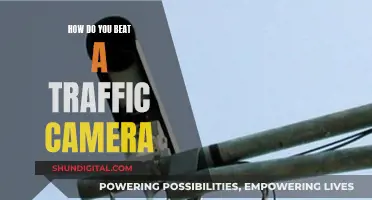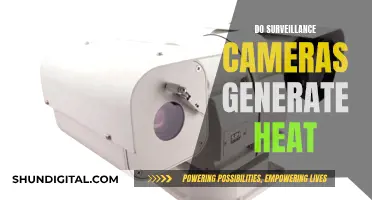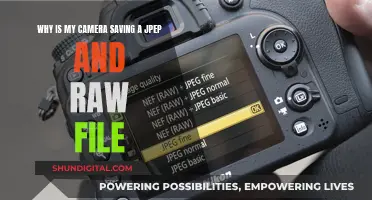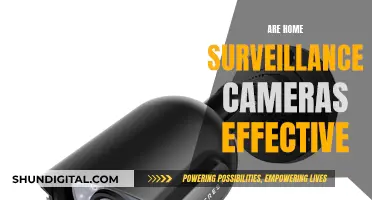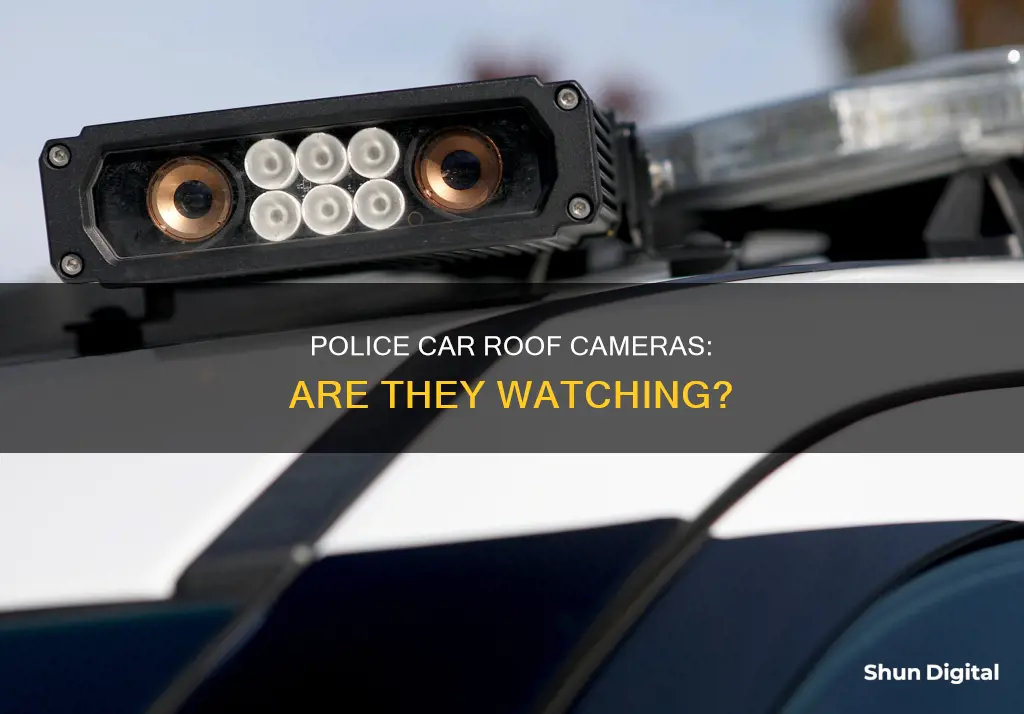
Police cars are often equipped with cameras, which can be mounted on the roof or trunk of the vehicle. These cameras are part of an automatic license plate reader (ALPR) system, which is used to capture images of license plates and check them against various databases. In addition to this, police cars may also have multiple-camera video systems that provide a panoramic view of the surrounding area, with cameras facing the front, back, and sides of the car, as well as one focused on the back seat. These camera systems serve to protect both the officers and the public, providing an independent record of events that can be used as evidence in court and for monitoring officer activity.
| Characteristics | Values |
|---|---|
| Camera Placement | Mounted on the roof or trunk of police cars |
| Camera Purpose | Part of an automatic license plate reader (ALPR) system |
| Functionality | Snap pictures of license plates, and look up the vehicle's registration |
| Capabilities | Scan and research up to 1,800 plates per minute, even at speeds of 150 mph |
| Activation | Automatically activated when the car is turned on, or manually when the officer pushes an event record button |
| Data Storage | Requires purchasing servers to accommodate the large amount of data |
What You'll Learn

Cameras provide a panoramic view
Police cars may have cameras on the roof or trunk, which are often used as part of an automatic license plate reader (ALPR) system. These cameras can snap pictures of license plates, and a computer in the car looks up the vehicle's registration. However, some police cars are also equipped with a multiple-camera video system that provides a panoramic view of the surrounding area.
The Palo Alto Police Department, for example, has installed a five-camera video system on all 26 of its police cruisers. These cameras provide high-definition video and high-fidelity audio. One camera is positioned at the front windshield, similar to a traditional dashboard camera, while another faces out the back. The other two cameras are mounted on the sides of the car and are built into the light bar. According to Lt. Zach Perron, the public affairs manager, these four exterior cameras "provide a 270-degree view around the police car".
The fifth camera is directed towards the back seat to monitor any prisoners. The system automatically records video as soon as the car is turned on and can capture up to 40 hours of footage. The audio is activated when the officer pushes an event record button or when certain triggers are met, such as when the red lights on top of the car are on or when the car exceeds a certain speed.
The panoramic view provided by these camera systems offers several benefits. For instance, it helps preserve an independent, objective record of what the officer encounters, which can be used as evidence in court and to increase accountability by monitoring officer activity. The footage can also assist in investigations, such as in the case of a reported burglary where video from a side-view camera showed a suspect vehicle in the area.
Additionally, the system includes a microphone that the officer wears on their belt, allowing for audio transmission even when the officer is out of the camera's view. This enhances the overall situational awareness and can provide valuable context to the recorded video footage.
The Evolution of Rolleiflex Cameras: Past, Present, and Future
You may want to see also

Cameras are used for automatic license plate readers
Cameras are often used for automatic license plate readers (ALPRs) on police cars. These are high-speed, computer-controlled camera systems that are mounted on the roof or trunk of police cars. ALPRs are also installed on street poles, streetlights, highway overpasses, mobile trailers, or in fixed locations such as traffic lights and freeway exit ramps.
ALPRs automatically capture all license plate numbers that come into view, along with the location, date, and time. This data, including photographs of the vehicle and sometimes its occupants, is then uploaded to a central server. The data can be used by police to find out where a plate has been, identify travel patterns, and even discover associated vehicles.
The most advanced ALPR systems can scan and research up to 1,800 plates per minute, even reading tags on cars racing by at speeds of up to 150 mph. The system can capture images of traffic passing a parked police car, or parked cars while the police car is moving. The system then checks these license plates against local, state, and federal databases, alerting the officer if a plate of interest is found.
ALPRs have proven effective in stopping crimes. For example, when an APB is put out on a vehicle suspected of being involved in a kidnapping or robbery, it can often be quickly located using ALPR data. Historical data can also be used to predict a suspect's next move. ALPR data was used to help catch a kidnapper in 2017, and to identify one of the rioters at the U.S. Capitol in 2021.
However, there are privacy concerns surrounding the use of ALPRs. The data can be used to create an intimate portrait of a driver's life, and it can be shared with thousands of other law enforcement agencies. There is also the potential for abuse, with officers targeting certain communities or misusing the data. Additionally, there are questions about the retention of data, with some agencies storing ALPR data for several years, or even indefinitely.
The Magic Behind Auto-Focusing Cameras
You may want to see also

Recordings are used as evidence in court
Many police cars are equipped with cameras on their trunks or roofs, which are used as part of an automatic license plate reader (ALPR) system. These cameras capture images of license plates, which are then checked against local, state, and federal databases to identify vehicles of interest. The data collected by these cameras has proven to be very effective in stopping crimes and locating suspects.
Recordings from police car roof cameras and police body-worn cameras are frequently used in court as evidence. This footage can provide a detailed, first-hand account of police interactions with victims, witnesses, and defendants, increasing transparency and accountability. It can be used to corroborate an officer's testimony, verify their account of the circumstances surrounding an arrest, and dispel allegations of wrongdoing. For example, in the case of City of Topeka v. Murdock, body-worn camera footage was used to demonstrate that a defendant had given consent for a search, meeting the consent exception to the search warrant requirement.
When presenting camera footage as evidence in court, several legal considerations must be addressed. Firstly, the footage must be authenticated by a witness with knowledge of its contents, typically the officer who wore the body camera or drove the car. Secondly, the footage is subject to rules regarding hearsay, where any statements made outside of the current trial must fall under a hearsay exception to be admitted. Additionally, the probative value of the footage must be weighed against its potential prejudicial effect on the defendant, ensuring that the evidence does not unfairly influence the jury's decision-making.
The use of body-worn camera footage in court may also raise constitutional issues, such as the defendant's right to confront and cross-examine witnesses under the Sixth Amendment's Confrontation Clause. While courts have not yet reached a consensus on this matter, it underscores the complex legal considerations surrounding the use of camera footage as evidence.
In summary, recordings from police car roof cameras and body-worn cameras play a significant role in the legal process, providing valuable evidence that can shape the outcome of a trial. However, their use is subject to strict evidentiary rules and legal interpretations to ensure a fair and impartial judicial process.
Launching Images in Camera Raw: A Step-by-Step Guide
You may want to see also

Recordings increase accountability by monitoring officer activity
Police cars are often equipped with cameras that serve various purposes, including monitoring officer activity and reading license plates. These cameras are typically mounted on the trunks or roofs of the vehicles and are designed to provide a broad view of the surrounding activity.
The presence of cameras in police cars increases accountability and transparency in law enforcement. The recordings from these cameras can be used as evidence in court and to monitor officer behaviour, ensuring that they act appropriately and follow protocols. This not only protects the public from any potential misconduct but also safeguards officers from frivolous complaints.
For instance, the Palo Alto Police Department equipped all 26 of their police cars with a five-camera video system, which included high-definition video and high-fidelity audio capabilities. This system provided a 270-degree view around the vehicle, capturing interactions between officers and members of the public. The recordings helped preserve an independent, objective record of incidents, allowing for better accountability and improved trust in law enforcement.
In addition to the cameras on police cars, the officer in the field may also be equipped with a body-worn camera. These body-worn cameras provide a first-person view of the officer's interactions and activities, further increasing transparency and accountability. The footage from these cameras can be reviewed by supervisors to ensure that proper procedures are being followed and to identify areas for improvement in training or protocol.
The use of cameras in police cars and on officers has been shown to have a positive impact on community relations and trust in law enforcement. By increasing transparency and providing an objective record of events, these recordings help to hold officers accountable for their actions and ensure that the rights of citizens are respected. This technology plays a crucial role in upholding the integrity of law enforcement agencies and improving public safety.
Reducing Camera Noise: Tips for Sharper Raw Images
You may want to see also

Cameras are automatically activated when the car is turned on
Police cars are often equipped with cameras that serve various purposes, such as automatic license plate readers or providing a panoramic view for officers. These cameras are typically mounted on the trunks or roofs of police vehicles.
While the specific activation mechanisms may vary across different police departments and camera systems, it is common for cameras in police cars to be automatically activated when the car is turned on. This ensures that the cameras are operational as soon as the officer starts their shift or responds to an incident.
For instance, in Palo Alto, California, the police department's fleet of 26 cars is equipped with a multiple-camera video system that automatically starts recording as soon as the ignition is turned on. This system includes five separate cameras that capture high-definition video and high-fidelity audio. The cameras are strategically placed, with one facing the front windshield, another facing the rear, two mounted on the sides, and a fifth camera focused on monitoring the back seat prisoner.
Having the cameras automatically activated when the car is turned on provides several benefits. Firstly, it ensures that the entire shift is recorded, allowing officers to capture crucial footage during their patrol. This helps in preserving an independent and objective record of the officer's encounters, which can be used as evidence in court or to increase accountability by reviewing officer activity.
Additionally, automatic activation eliminates the need for officers to remember to turn on the cameras manually, reducing the risk of human error or forgetfulness. This feature streamlines the process and ensures that the cameras are always operational when needed.
Exploring Las Vegas: The City Under Constant Surveillance
You may want to see also
Frequently asked questions
Yes, police cars can have cameras on the roof or trunk. These are often used for automatic license plate reading systems.
These systems snap pictures of license plates and run them against local, state, and federal databases. They can scan up to 1,800 plates per minute and can identify plates on cars racing by at up to 150 mph.
The system automatically activates when the police car is turned on and can capture up to 40 hours of video. Audio is recorded when the officer pushes an event record button or when the system goes into event mode, which happens when the red lights are on, the car exceeds 80 mph, or the car is in an accident.
The cameras help to preserve an independent, objective record of what the officer encounters. The recordings are used as evidence in court and to increase accountability by monitoring officer activity.
Not all police cars have roof cameras. The presence of cameras may vary depending on the police department, available resources, and specific operational requirements.


